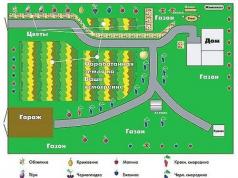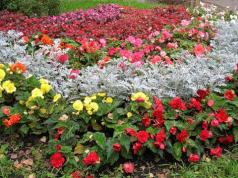Abundant, early flowering almonds grown in the south can forever be remembered for their splendor. Pink flowers, sweet aroma remind of distant lands and endless summer. But the almond tree is not exotic at all. In temperate latitudes, its cultivation is quite possible. Zoned varieties are not only decorative, but bring good yields of useful fruits.
If in winter the air temperature does not drop below 25 ° C, then the shrub may well grow in the open ground of an ordinary garden. Subject to several rules, almonds produce from 6 to 10 kg of fruit per season and live up to 100 years.
How to grow almonds: planting according to all the rules
Blooming almonds can transform the entire garden, give it an exotic look. The southern heat-loving handsome man in nature grows on rocky slopes, is demanding of light. What conditions will be optimal for its growth? The place reserved for the "almond garden" must meet several requirements.
1. Soil quality. Rocky, sandy, well-drained soils work best. Loams, clayey soil must be limed, to improve air permeability. Almonds feel good on rocky decorative slides.
2. A light-loving shrub should be placed so as not to shade it for more than a few hours a day.
3. Plants develop well, covered from cold winds. The best choice is the south side of the slope or a place closed from the north by buildings, a fence, but open to sunlight from the south.
4. With stagnant water, the almond root may die. Therefore, places subject to prolonged accumulation of moisture are not suitable for planting.
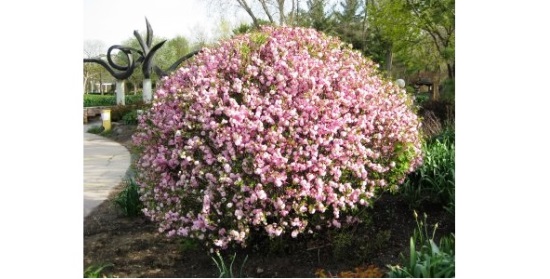
Almond is a culture demanding for pollination. The amount of future harvest directly depends on this. Neighborhood with bee hives will be an additional plus when choosing a place. Early flowering will provide prudent owners with fragrant spring honey.
Ways to grow almonds
Once a site has been chosen, it is time to decide how the plant will be grown. There are several ways to propagate almonds:
Growing from the bone;
Graft;
Rooting layering and cuttings;
Planting a grafted seedling.
The first method is the most time-consuming, vaccination will require certain skills, the last method is easier than others. Let's start simple.
Almonds: planting a seedling, a brief instruction with a photo
If there are zoned varieties on sale, the problem of buying planting material is reduced to choosing between seedlings of ornamental and table varieties. Grafted seedlings from a conscientious seller are guaranteed to have the properties of the declared variety.
When buying, it should be borne in mind that for full fruiting, almonds need to be pollinated. Therefore, to obtain a crop, it is necessary to plant several plants, preferably different varieties.
Planting a seedling is not a difficult event:
1. Preparing the landing hole. The size of the planting hole will tell you the size of the root. For a one-year-old plant, usually a hole up to 60 cm deep and of the same diameter is enough. The bottom should be covered with a layer of rubble, broken bricks and sand. This ensures the necessary drainage, excess moisture can not harm the young plant.
2. The distance between the holes should be kept within 3 m. So the bushes growing up and in breadth will not obscure each other from the sun.
3. The soil for filling the hole is fertilized with superphosphate (no more than 0.5 kg per plant), rotted manure (about 5 kg); be sure to lime by adding 1 cup of dolomite flour or lime.
4. At first, the seedling needs support. In the center of the landing pit, a long pole, stick or bamboo support is stuck deeper. The roots are distributed along the bottom of the hole, avoiding bending upwards.
5. When filling up a hole, they carefully monitor that the grafting site remains above the soil level.
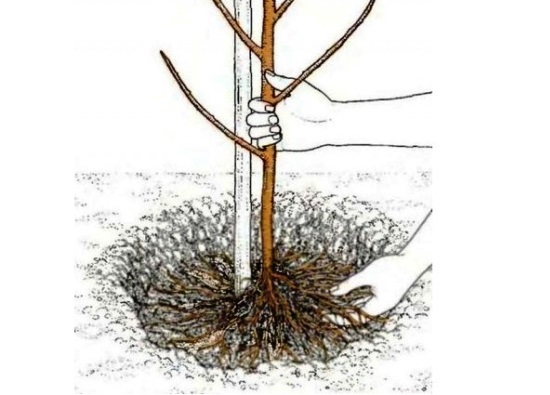
That's all the basic wisdom of landing. Each plant should be watered abundantly; later, keep the land around clean. Almonds do not tolerate basal vegetation, even ordinary grass.
In the first year, the bushes grow reluctantly - mainly the root system develops. But subsequent years will please the active growth of the bush. Almond blossom, with care and proper feeding, begins at 4 years of age.
Almonds grown from seed
You can grow a shrub using seeds. Almonds are grown (as in the photo) in the house to the size of a seedling, or seeds are sown directly into the ground in spring. It is not always possible to preserve species characteristics by such reproduction.
Planting seeds in the fall on the street is not recommended. Their smell attracts rodents. By spring, there may simply be nothing to rise. All seeds intended for sowing must "overwinter" in containers with wet sand, at a temperature not exceeding 10 ° C. This will increase their germination, have a beneficial effect on future crops.
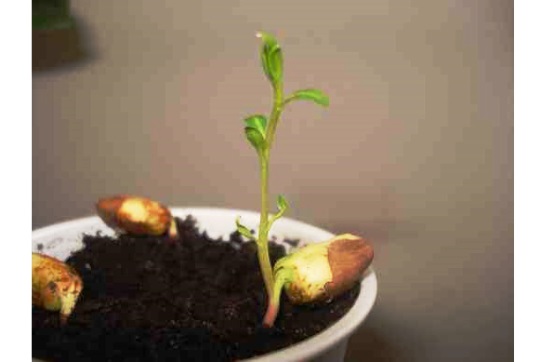
When transplanting a young sprout, you should pinch the root, for the uniform development of the aboveground and underground parts of the plant.
Vegetative propagation of almonds
If you have an adult plant of the desired variety, you can propagate in several more ways.
Cuttings obtained by pruning. Cuttings up to 20 cm long, take root well in wet sand, in a cool place.
Root growth regularly appears around the bushes. Leaving a few sprouts during pruning, in the second year you can get a finished seedling with a developed root system.
Layers are low-growing branches that easily root when in contact with the soil. Having pinned such a branch to the ground, covering it with earth, it is enough to wait for the roots to appear. Separating the rooted branch from the mother bush, it can be planted as an independent plant.
Almonds: care for an adult plant
Almonds are unpretentious in care. He will need only regular watering, top dressing, timely pruning.
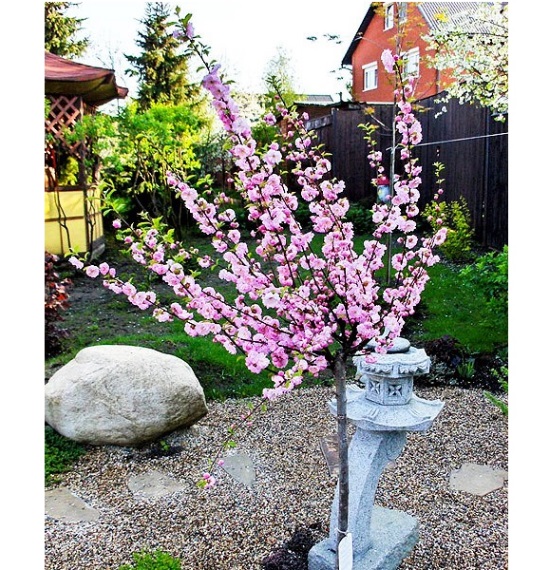
The formation of the crown begins from the moment of planting. A seedling planted in spring is immediately shortened to a height of 80 cm. Lateral branches are cut into three buds. Almonds are grown both as a bush and as a small tree. The main task is to form a sparse crown. All damaged, thickening, fruiting shoots should be removed.
Formative pruning is carried out after flowering. Peach and almond equally love pruning, their crowns are formed according to the same principle - more air and light. The fan type of crown formation has proven itself well.
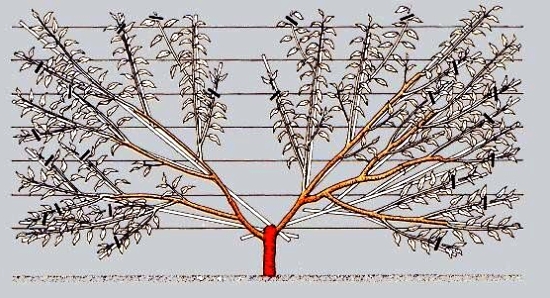
The appearance of an adult almond is laid in the first years, and depends on the height of the central trunk, which was originally planted.
When watering almonds, it is important to observe the "golden mean". Lack of moisture leads to poor flowering and fruiting, and with excess moisture, the root neck easily rots. When the soil dries to a depth of 2 cm, it is enough to spend 10 liters of water per plant when watering.
Stone fruit crops are demanding on top dressing. Fertilization with copper-containing preparations is appropriate in early spring. The spring-summer period is the time of nitrogen and potassium fertilizing. Closer to autumn, superphosphates are relevant.
Helping almonds survive the cold
A few tricks from experienced gardeners will help the plant survive the winter without significant losses.
In July - August pinch the apical buds on the shoots. The shoots will ripen faster, endure the winter more easily.
Seedlings are wrapped for the winter (for example, with lutrasil). The trunk circle is also covered with special materials or mulch.
When hilling the bole with snow, there is a danger of warming the root neck.
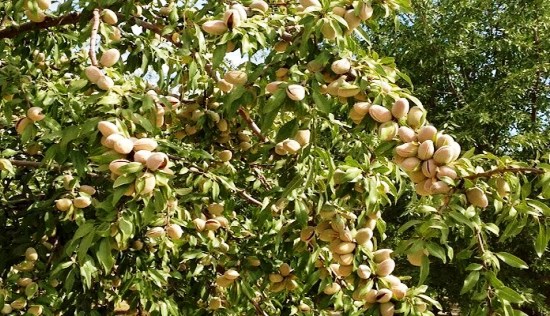
Existing varieties of almonds, with care and due attention, make it possible to grow a heat-loving plant even in Siberian conditions. Southern aroma, beauty of flowers, healthy and tasty almond nuts will be a well-deserved reward for a patient gardener.

